
In a plan to capitalize on “the future of personal mobility,” GM will build a fleet of self-driving 2017 Chevrolet Volts for employees at the newly-renovated Warren Technical Center in Michigan. Set to embark in late 2016, the vehicles will be reserved by GM staffers via a car-sharing app, which will allow them to pick a car and select a destination. Once a vehicle has been claimed, the autonomous Volts will pick up their passengers and ferry them to their destination without any driver input.
According to the brand’s press release, “The program will serve as a rapid-development laboratory to provide data and lessons to accelerate the company’s technical capabilities in autonomous vehicles.” GM has been developing a self-driving system called “Super Cruise” for the last three years, and confirmed it will be available on the 2017 Cadillac CT6.

In other news, GM CEO Mary Barra and GM Executive Vice President of Global Product Development Mark Reuss revealed plans to co-develop a hydrogen fuel cell vehicle with Honda, and they expect the car to be ready for public use by 2020. The company also divulged that it is pursuing non-automotive uses for the fuel cell technology, including aerospace and military applications.
“The convergence of rapidly improving technology and changing consumer preferences is creating an inflection point for the transportation industry not seen in decades,” said Barra. “Some might find this massive change to be daunting, but we look at it and see the opportunity to be a disruptor. We believe our decades of leadership in vehicle connectivity is fundamental to our quest to redefine the future of personal mobility.”


